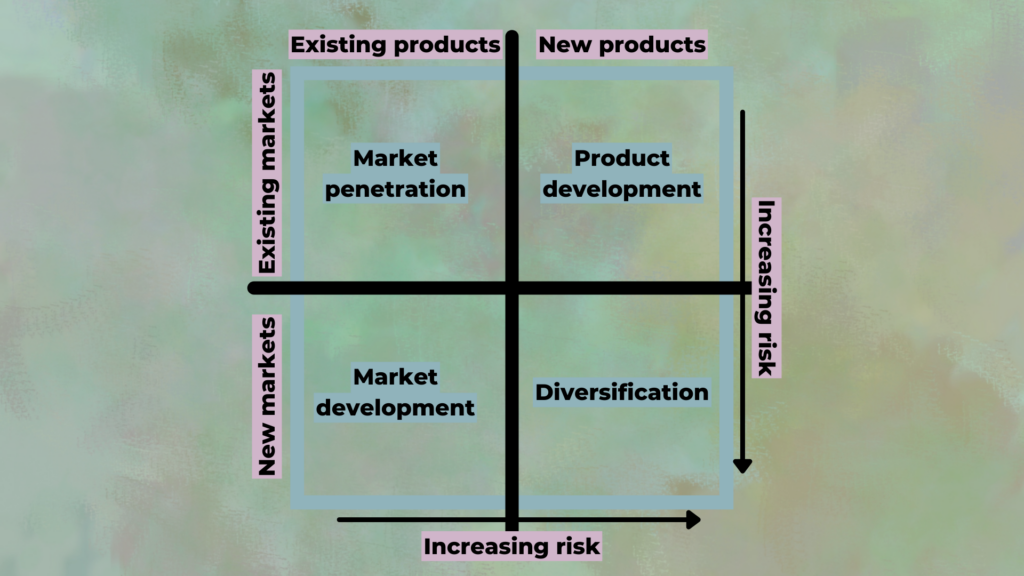
NEWS & PRESS
A business growth strategy for your cannabis brand
We all want growth.
To achieve it, you’ll need a great product that’s well pitched, and a strategy for making lasting connections.
There are plenty of models you can use to approach your growth strategy, but we’ll share one. An oldie but a goodie. One that takes a bird’s eye view of your whole operation and can be the easy first step in your business marketing plans.
The Ansoff Matrix was created by mathematician and business manager Igor Ansoff in 1957. Ansoff said there were only two ways to develop a growth strategy: through changing what is sold (product growth) or who it is sold to (market growth).

Growth strategies in the matrix
The matrix offers four ways to grow your business. The strategy that makes the most sense for you will depend on your business model, the level of competition in your state or market, your current financial situation and risk appetite, and what is happening in the cannabis space.
Market penetration
Risk level: Low risk
When to use: When your market is still expanding, you have a good customer base who like your products but you need to reach more people.
A market penetration strategy includes all the activities that will help your business capture a larger share of your existing market. It’s selling more of your existing product range to your existing target customers. It’s low risk because it doesn’t involve any market or product research or production. It forces you to look at your communication and distribution and ask, ‘how can we take this to the next level?’.
Examples: Adding a click and collect option to your website, doing local events with complementary brands, increasing your opening hours, reducing your prices, creating bundle offers, adding a loyalty program, improving your distribution networks
Product development
Risk level: Medium risk
When to use: you have a decent customer base who you know well, but you’ve exhausted a lot of your options to keep selling to them
A product development strategy is engaging your existing customers with new products. It’s medium risk because developing a new product can be time consuming and expensive. But it’s made a lot easier if you have a deep and thorough understanding of the people who already like your brand. Product development can also involve improving your existing product by adding new features or functions.
Examples: adjusting your vape products to add reassuring messaging, introducing more 50:50 CBD:THC options, partnering with a complementary fashion brand on rolling papers, trays, or lighter case, introducing unique and seasonal edible options, investing in new product research
Market development
Risk level: Medium risk
When to use: you’re confident in your product, you have great feedback, but it’s just not reaching the right people.
Market development is selling your existing products to new markets. It can be tricky to understand the nuances of new markets. Here you’ll embrace new channels and routes to market, as well as new promotional tactics. It’ll be strongest when you take time to understand how your new audience thinks.
Examples: creating new product packaging, adjusting your pricing strategy, opening your events to high end venues, establishing your business in another state, revamping your visual branding to tune up or down your formality or friendliness
Diversification
Risk level: High risk
When to use: Your core business is stagnant or in decline, or you need to spread your risk because of an unpredictable shift in the market. You have an idea that you just can’t shake that can still fit under your brand.
Diversification is a growth strategy that involves developing new products to sell into entirely new markets. It’s exciting to explore new paths, but it comes with risk. Though you can offset some of the risk with thorough market research. There are two diversification tactics; related diversification, and unrelated diversification. Related diversification is staying in the same field, and unrelated diversification is venturing into something new with no industry relationships or experience. Related diversification is your tinctures company making pre-rolls for a cannacurious customer base. Unrelated diversification is your company creating a ‘scent of forest bathing’ perfume.
There are three ways to test whether diversification will be successful
- The Attractiveness Test: How attractive is the new market?
- The Cost of Entry Test: How expensive is it to enter the market?
- The Better Off Test: How will the company be in a better position?
Examples: starting a business incubator for new cannabis brands, bringing out a national cannabis cookbook, launching advice events for home growers, starting a wellness retreat

